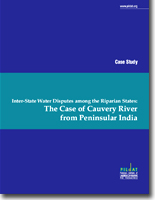Differences exist among the federating units in Pakistan over the distribution and development of Indus water resources. Despite the fact that the provinces had signed a landmark Water Apportionment Accord in 1991, the differences over the interpretation of the accord continue to stall the development of water reservoirs and construction of hydro-electric projects especially on river Indus. These differences are not unique to Pakistan. Wherever a river passes through more than one country or more than one units within a country, the upper and lower riparians generally face these differences. While studying the current inter-provincial water issues in Pakistan and promoting a dialogue among various stakeholders with the aim to resolve such issues, PILDAT tried to look outside Pakistan for similar inter-provincial disputes among the units of a country to learn how those countries and units of a country have tried to resolve the differences. The objective is to learn from other cases similar to ours while trying to address our inter-provincial differences over river water. It was in this background that PILDAT requested Mr. K. J. Joy and Mr. S. Janakarajan in India to describe the case of an interstate (states in India are the equivalent of provinces in Pakistan) water dispute in India and how the efforts have been made to resolve such a dispute. The two eminent professionals in India graciously agreed to author this case study on Inter-state Water Disputes among the Riparian States: The Case of Cauvery River from Peninsular India. It is an extremely interesting case study. Although the dispute is far from resolved, there are several lessons to be learnt from the case. Similarities in the socioeconomic conditions of India and Pakistan make the Case Study even more relevant and useful for Pakistan. We hope that this case study will help in putting the Pakistani Inter-provincial Water disputes in a broader context and help Pakistani experts and stakeholders in using the lessons learnt through the Indian case study.







